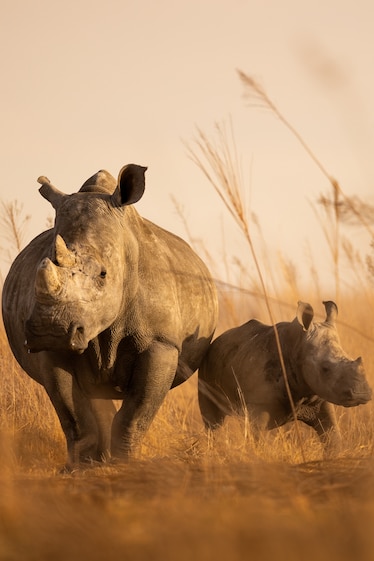About 2,000 white rhinos living on the world’s largest rhino farm will be released into the wild as part of a new deal struck between farm owner John Hume and the conservation nonprofit African Parks.
Hume, an entrepreneur who for years lobbied to sell the animal’s horns, had put his entire 21,000-acre farm in South Africa and all its animals up for auction in April with an initial asking price of $10 million. He received no bids for the farm, which is called the Platinum Rhino Conservation Project. (Watch our TikTok about the rhino farm.)
Instead, under a private deal between Platinum and African Parks, the nonprofit acquired the farm, its thousands of rhinos, and numerous other animals including giraffes, hippos, sheep, and more.
Taylor Tench, a senior policy analyst who specializes in rhinos at the Environmental Investigation Agency, a watchdog group with offices in the United States and United Kingdom, called this deal one of the “most positive outcomes that could have arisen from this situation.” He cautioned, however, that the challenges of rewilding the animals are “incredibly daunting.”
African Parks manages 22 national parks and protected areas across 12 countries in Africa, and it says it will be keeping all of Platinum’s staff employed to care for the animals until they can be relocated to the wild. The nonprofit also confirmed to National Geographic that it will continue the farm’s current security operations to prevent poaching, including helicopter patrols, dozens of armed game rangers with guard dogs, and more.
In documents from the auction, Hume noted that he spends more than $425,000 per month protecting the animals from poachers. But the approach appears to be effective. The farm’s last known poaching incident occurred in March 2017, and African Parks says that it considers the security to be state-of-the-art.
Future destinations
African Parks says it aims to have all the animals in their new homes within the decade, but exactly where the animals will be going in the wild, when, and how the group will be broken up have not yet been determined.
The nonprofit is launching feasibility studies to decide where the animals could go and still have adequate levels of food and water, among other factors. Lands currently managed by African Parks as well as other available areas in Africa may be considered as possible destinations.
“An advisory group is being put in place, and all decisions will be guided by a framework that is currently in development,” says Donovan Jooste, who is overseeing the project for African Parks. Mother and calf units will be translocated together, he says, but exact groups and group numbers will be determined on a case-by-case basis. The security of recipient areas will also be assessed prior to any release as part of the rewilding program.
“A lot of questions remain which African Parks will have to address moving forward, but it’s a very positive vision,” Tench says. Keeping rhinos safe in the wild continues to be a challenge. Kruger National Park, for example, has seen its rhino population plummet from more than 10,000 in 2010 to fewer than 4,000 due largely to poaching and its consequences for breeding and calf survival.
The price for the animals and other details of the deal were not disclosed by Hume or African Parks, though the nonprofit says they paid a “small percentage” of the listed auction price. Tammy Hume, the auction’s spokesperson and John Hume’s daughter-in-law, says that she cannot disclose details of the deal under a non-disclosure agreement.
There are about 22,000 rhinos across all of Africa, meaning Hume’s almost 2,000 white rhinos comprise a sizable portion of the world’s wild population of the species.
Horns for sale—or not
When Hume began operations at his Platinum Rhino Conservation Project, he aspired to protect rhinos from poachers and simultaneously breed the animals to increase their numbers, saying he would fund the operation with rhino horn sales. Yet the financing of the venture never took off since the international sale of horns was never legalized. (Read more: Rhino Wars)
The decision to put the animals up for auction was made in the hopes that deep-pocketed investors would be able to buy the animals to eventually rewild them, Tammy Hume told National Geographic in April.
The deal with African Parks represents a win for the thousands of animals, says John Scanlon, a former special envoy for African Parks and former secretary general of CITES, the global treaty that regulates wildlife trade and prohibits international horn sales.
“I think it’s a courageous move on the part of African Parks,” he says. “I can’t think of any other organization that would have the courage and capacity to take on something of this scale and risk.”
When lands are well-managed, he adds, relocated animals can be kept secure from poachers and have strong survival numbers. African Parks, he says, “will give the animals their best chance.”
